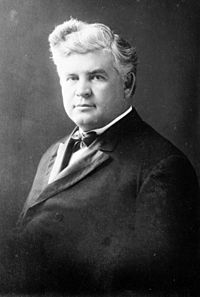Henry Thomas Rainey
| Henry Thomas Rainey | |
|---|---|
 |
|
| 40th Speaker of the United States House of Representatives | |
|
In office March 9, 1933 – August 19, 1934 |
|
| President | Franklin D. Roosevelt |
| Preceded by | John N. Garner |
| Succeeded by | Joseph W. Byrns, Sr. |
| House Majority Leader | |
|
In office December 7, 1931 – March 3, 1933 |
|
| Preceded by | John Q. Tilson |
| Succeeded by | Joseph W. Byrns |
| Member of the U.S. House of Representatives from Illinois's 20th district |
|
|
In office March 4, 1903 – March 3, 1921 March 4, 1923 – August 19, 1934 |
|
| Preceded by |
James R. Williams Guy L. Shaw |
| Succeeded by |
Guy L. Shaw Scott W. Lucas |
| Personal details | |
| Born | August 20, 1860 Carrollton, Illinois |
| Died | August 19, 1934 (aged 73) St. Louis, Missouri |
| Political party | Democratic |
| Alma mater |
Knox College Amherst College Union College of Law |
| Profession | Law |
Henry Thomas Rainey (August 20, 1860 – August 19, 1934) was a prominent U.S. politician during the first third of the 20th century. He served in the United States House of Representatives from 1903 to 1921 and from 1923 to his death as a Democrat from Illinois, and was its Speaker during the famous Hundred days of Franklin D. Roosevelt in 1933, and the last Speaker of the House born before the Civil War.
Rainey attended the public schools and Knox Academy and Knox College, Galesburg, Ill. he transferred to, and graduated from Amherst College in 1883 and then the Union College of Law, in Chicago which he graduated in 1885. He was admitted to the bar in 1885 and commenced practice in Carrollton, Ill.
Rainey was appointed master in chancery for Greene County, Ill., from 1887 until 1895, when he resigned, and returned to private practice. He then decided to return to politics in 1902 getting elected to Congress and serving for nine terms before losing to Guy L. Shaw in 1920. Two years later, he won back his seat and served until his death.
Due to the Great Depression, the Republican party lost its majority in a landslide, and, with John Nance Garner elevated to the Speakership, Rainey ran for, and defeated John McDuffie for the Majority leadership. McDuffie remained as Whip.
With Speaker Garner having been inaugurated Vice President on March 4, 1933, Rainey, being next in line, was elected Speaker of the House when President Roosevelt called a special session of Congress two days later. Rainey gave the Roosevelt administration carte blanche to do whatever it wanted, allowing almost the entire New Deal to be passed with little or no changes.
...
Wikipedia
